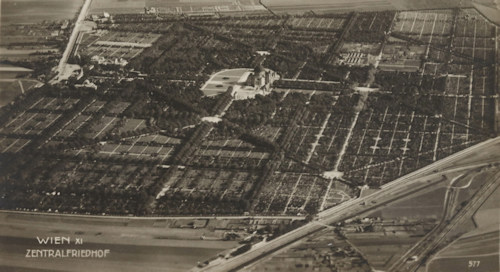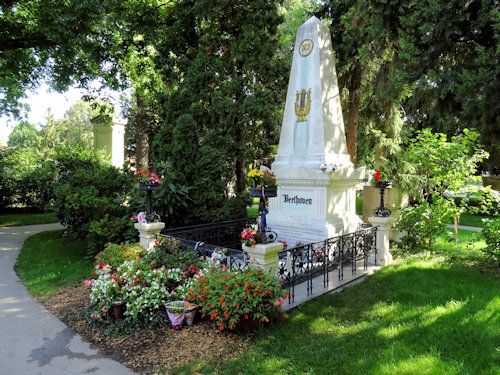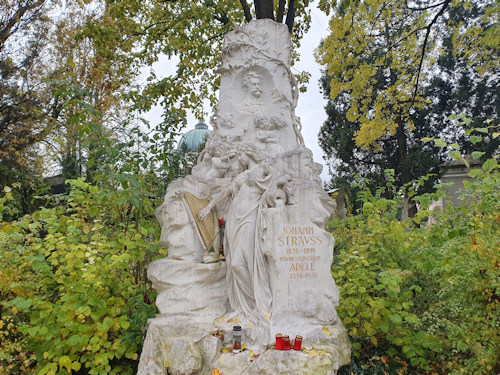
Vienna’s main cemetery – the Zentralfriedhof – is a curious place. Although a working cemetery and home to some particularly famous graves, it’s almost as well-known for its flora and fauna.
- Vienna’s largest cemetery
- Many famous graves
- including composers like Beethoven & Strauss
- Cemetery church is a Jugendstil classic
- Like a huge landscaped park in many areas
- Also home to the rare European hamster
- A little away from the centre, but easily reached by car or tram
- Book a themed guided tour* of Vienna
- See also:
The central cemetery

(View down to the church)
The history
One of the problems for a growing city is where to put all the people. And not just the living ones.
As Vienna neared the end of the 19th century, it became clear existing cemeteries weren’t up to the long-term storage job.
So the authorities raided the savings account and bought up a large plot of land to the southeast of the city. They turned the area into a new cemetery, which opened officially on November 1st, 1874 with the burial of a certain Anton Seifert.

(The Zentralfriedhof – aerial photo from ca. 1919; produced by the Verlag Luftbild Ges.m.b.H.; Wien Museum Inv.-Nr. 306250; excerpt reproduced with permission under the terms of the CC0 licence)
This Zentralfriedhof now occupies just under 2.5 million m2, with some 330,000 graves and crypts, and around three million “inhabitants.” This makes it one of the biggest cemeteries in the world, perhaps second only to the Wadi-us-Salaam cemetery in Iraq.
As a multi-denominational institution within a largely Catholic Austria, the location also includes dedicated sections for Judaism, Islam, Buddhism and various Orthodox churches.
Famous graves

(Beethoven’s last resting place)
The Zentralfriedhof initially found little public approval, thanks to the distance from the centre. So little, in fact, that the authorities had to think of ways to make it more attractive.
One tactic involved ensuring a few famous people were laid to rest there in so-called Ehrengräber (honorary graves). They even moved the likes of Beethoven and Schubert there from their original burial locations.
Today, Ehrengräber are still a way for Vienna and Austria to honour particular citizens. If you get one, the city also commits to looking after it.

(The grave of Johann and Adele Strauss)
Browse the long listings of such Ehrengräber in the Zentralfriedhof, and you find a few famous names you might recognise even as a visitor.
On the musical front, you have the aforementioned Beethoven and Schubert, but also various members of the Strauss family, Brahms, Salieri, Schoenberg, Gluck, Lanner, Falco, and others.
Among the artists, designers, scientists, industrialists and similar are, for example, such figures as Hollywood actress and noted inventor Hedy Lamarr, painter Maria Lassnig, and physicist Ludwig Boltzmann. Not to mention past Austrian presidents.
Nature and architecture

(The church building remains a classic of Jugendstil design)
The gravestones vary from the extraordinarily large and ornate to the small and simple. The Jugendstil Church of St. Charles Borromeo (consecrated in 1911) provides the central architectural feature.
Wandering through the cemetery aisles on a sunny day certainly makes for a decidedly tranquil experience, filled as the area is with trees, shrubs, and flowers. The authorities keep it in remarkably good condition.

(Find ponds, meadows and small wooded areas)
The Zentralfriedhof has also become a kind of nature reserve with open parkland, wilderness areas, bee hives and insect hotels. It provides a home for around 17,000 trees.
Films have even been made on the cemetery’s animal population. And not just for local TV: for example, parts of the wild hamster section in the BBC’s Seven Worlds, One Planet documentary came from the Zentralfriedhof.
We met one of these critically endangered animals on our last trip there (apologies for lack of sharpness, but old smartphones weren’t designed for closeups of nimble European hamsters):

(Not your usual cemetery inhabitant)
The location also makes regular appearances in cultural media.
For example, the cemetery played a role in at least two episodes of the period detective drama, Vienna Blood as well as in the Oscar-winning thriller, The Third Man.
The grave of a certain Carl Schweighofer even featured in the music video for Ultravox’s legendary Vienna single (and also adorned the original cover).
Tickets & visitor tips
As long as you’re not entering as part of a paid 3rd-party guided tour, the Zentralfriedhof charges no fee to go in. It opens every day.
The main entrance at Tor 2 (Gate 2) has a small shop with the kind of souvenirs you’d expect when a cemetery meets Vienna’s indigenous pessimism and macabre sense of humour. You can also pick up an English-language guide to the Ehrengräber there.
Just next to the shop is a branch of the Konditorei Oberlaa chain. This lovely patisserie and coffee shop proves the old Viennese adage that nothing in life is certain except, death, taxes, and cake.
A bus service operates inside the cemetery itself, and you can borrow ebikes. We chose to walk around (everything is flat with clear and well-kept paths and roads).
How to get to the Zentralfriedhof
The literal translation of Zentralfriedhof is “central cemetery,” but there’s nothing remotely central about it. Even today, it’s a 20-minute tram ride from the edge of the city centre.
Train: The S7 city train service (which goes out to the airport) stops at the Zentralfriedhof station.
Tram: take line 71 or 11 to Zentralfriedhof 2.Tor. The 71 leaves from several central stops, such as Schottentor, Ring/Volkstheater, Oper/Karlsplatz or Schwarzenbergplatz. You can pick up the 11 (or 71) from the Simmering subway station, which is the end station of the U3 line that runs through the city centre.
There’s plenty of parking and you can even take your car inside (for a fee).
Address: Main entrance (Tor 2), Simmeringer Hauptstraße 234 , 1110 Vienna | Website